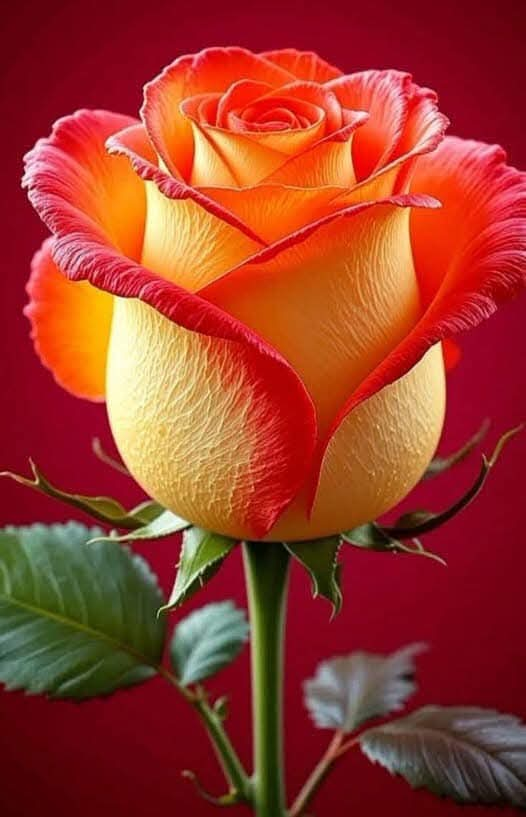Roses have long been symbols of love, passion, and elegance, but bi-color roses take their beauty to another level. The captivating rose in this image features a striking contrast of golden yellow petals with fiery red edges, making it a true masterpiece of nature. With their unique gradients and vibrant hues, bi-color roses are not just flowers—they are expressions of creativity and artistry in the plant world.
In this blog post, we will explore the significance, care, and gardening tips for bi-color roses, including why they make such a breathtaking addition to any garden or bouquet.
🌹 The Symbolism of Bi-Color Roses
Roses carry deep meanings depending on their color, and bi-color roses combine the symbolism of both hues in a single bloom.
Yellow: Represents friendship, joy, and warmth. It is associated with happiness, making it a wonderful color for uplifting spirits.
Red: The universal symbol of love, passion, and romance. It signifies deep emotions and admiration.
Together: A yellow and red rose symbolizes a love that is growing or developing—perfect for relationships that are blossoming. It can also represent enthusiasm, excitement, and new beginnings.
This combination makes bi-color roses ideal for anniversaries, weddings, and special celebrations, as they beautifully convey the message of deep affection and joyous energy.
🌱 How to Grow and Care for Bi-Color Roses
If you are enchanted by the beauty of bi-color roses, you can grow them in your own garden! They are not only visually stunning but also quite rewarding to cultivate with the right care.
Choosing the Right Variety
Bi-color roses come in many varieties, including hybrid teas, floribundas, and grandifloras. Some popular varieties include:
“Double Delight” – Creamy white with deep red edges.
“Cherry Parfait” – White petals with cherry-red tips.
“Joseph’s Coat” – A climbing rose with shifting colors from yellow to orange to red.
Select a variety that suits your climate, space, and gardening experience.
Planting Bi-Color Roses
🌞 Sunlight Needs
Roses thrive in full sun. Aim for at least 6-8 hours of direct sunlight per day.
Morning sunlight is best, as it helps dry moisture on leaves, reducing the risk of fungal diseases.
🌿 Choosing the Right Soil
Well-draining, loamy soil enriched with organic matter is ideal.
The soil pH should be between 6.0 and 6.5 for optimal growth.
🌱 Spacing & Planting Depth
Dig a hole twice as wide as the root ball and deep enough to accommodate the roots.
If planting multiple rose bushes, keep them at least 2-3 feet apart to ensure good air circulation.
Watering & Feeding
💦 Watering Tips
Water deeply once or twice a week, rather than frequent shallow watering.
Avoid wetting the leaves to prevent fungal infections like black spot.
🌿 Fertilizing for Vibrant Blooms
Use a balanced rose fertilizer (such as 10-10-10) every 4-6 weeks during the growing season.
Incorporate organic compost or manure to improve soil quality.
Stop fertilizing 6-8 weeks before the first frost to allow the plant to prepare for dormancy.
Pruning & Maintenance
✂️ When and How to Prune
Prune roses in late winter or early spring, just before new growth appears.
Remove dead, diseased, or weak branches to encourage stronger blooming.
Cut at a 45-degree angle above outward-facing buds for an open, well-shaped bush.
🦠 Pest & Disease Prevention
Watch for common rose pests like aphids, spider mites, and Japanese beetles.
Fungal diseases like powdery mildew can be prevented by ensuring good air circulation.
Use organic solutions like neem oil or insecticidal soap if needed.
💐 Bi-Color Roses in Floral Arrangements
Bi-color roses are highly sought-after for floral arrangements due to their stunning contrast and visual impact. They pair beautifully with:
White lilies or hydrangeas for an elegant, classic look.
Deep red roses for a romantic bouquet.
Bright orange or yellow flowers for a cheerful and vibrant arrangement.
They make perfect centerpieces for weddings, anniversaries, and other celebratory occasions.
🏡 Creative Ways to Use Bi-Color Roses in Your Garden
Beyond bouquets, bi-color roses can transform your garden into a magical space! Here are a few ideas:
- Create a Focal Point 🎯
Plant them in a dedicated rose bed or near entrances and pathways where they can be admired up close.
- Grow in Containers 🏺
If you have limited space, potted roses make a gorgeous addition to balconies, patios, and terraces.
- Companion Planting 🌿
Pair roses with lavender, catmint, or salvia to deter pests and create a visually appealing combination.
- Rose Arch or Trellis 🌿🌹
If using climbing bi-color roses, train them over an archway or trellis for a breathtaking garden entrance.
🌎 The Allure of Bi-Color Roses in Different Cultures
Roses are celebrated across cultures, and bi-color roses have unique meanings in different traditions:
In Victorian England, they were often used to convey hidden messages of passion and friendship.
In Eastern traditions, red and yellow symbolize prosperity, luck, and happiness.
In modern floristry, bi-color roses are seen as a symbol of uniqueness and rare beauty.
✨ Final Thoughts: The Magic of Bi-Color Roses
Bi-color roses are not just flowers—they are living art. Their stunning combination of warm golds, fiery reds, and delicate gradients makes them a favorite among gardeners and floral enthusiasts alike.
Whether you choose to grow them in your garden, gift them to a loved one, or display them in a bouquet, these roses never fail to impress.
🌹 Do you have bi-color roses in your garden? Share your experience in the comments! 💬👇
